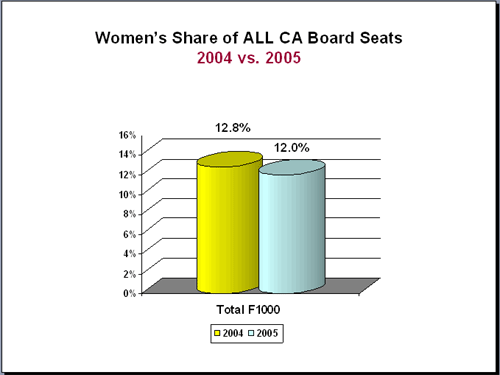The 2005 Survey of Women on Boards of California-Based
Fortune 1000 Firms
FOR IMMEDIATE RELEASE --- Santa Monica, CA (Update -- June 1, 2005)
Why Are Women Underrepresented as Directors on California
Boards?
Is the year 2005 one of the worst, or could it be one of the
best, yet, for women on boards of California Fortune 1000 public
corporations? What explains the "underrepresentation" of women?
Is it corporate culture? Is it the economy? Or is it other factors?
These questions are being addressed in research underway by Champion
Boards., a service of Santa Monica-based Technology Place Inc.
Now in its second year, the Survey of Women on Boards of California-Based
Fortune 1000 Firms has expanded its coverage to include the
new and better information resulting from stronger disclosure
requirements of the Sarbanes-Oxley Act of 2002, according to Elizabeth
Ghaffari, President of Technology Place Inc. and the founder of
Champion Boards, a service that provides women the knowledge and
information they need to reach their goal of becoming a member
of a board of directors.
The 2005 Survey covers California's 110 largest public companies from
the top tier Fortune 500 list (52 firms) and the bottom
tier Fortune 501-1000 list (58 firms) as reported in Fortune Magazine
in April of this year. Champion Boards reports that only Northern CA
top tier firms (those on the Fortune 1-500 list) showed an increase
in their share of women on boards of directors to 17.9%
in 2005, up from 17.3% a year earlier. Bottom tier Northern CA
firms (those on the Fortune 501-1000 list) and firms in Southern
CA (both top and bottom tier firms) decreased their percentage
shares of women on boards.
Overall, California's 110 Fortune 1000 firms dropped their share
of women on boards to 12.0% in 2005 compared to 12.8% last year.

The share of women on boards of directors pales in comparison to the economic contribution that women make in the marketplace. Today, women represent:
- 49% of all professional and managerial workers;
- the majority in nontraditional female occupations, including
those most valued by corporate boards of directors:
financial managers
accountants
auditors
economists and
- the majority of graduates of law and medical schools, among a host of other educational achievements.
"A major reason for the decline in women on boards in CA was the departure of just two large firms, WellPoint and Tenet, which relocated out of state. These two changes
resulted in CA's losing 5 women on boards," explained Ms. Ghaffari. "We know that firms with larger boards historically tend to have more
women on boards; but this year CA added only smaller firms with
their associated smaller boards. Some of these firms brought their
'first woman' to their board."
"Over the past decade, we've only added women to top corporate
boards at a rate of only one-half of one percent per year. To
move toward just a 40% share of women on boards, we need to
add a net of 145 new women to all Fortune 1000 U.S. boards every
year for the next fifteen years. To do that, we need 15 net new
women on CA boards each year."
"California has added 13 to 14 women to boards every year for
the past 4 years. With 3 women added in the 1st Q 2005, there's
hope for this year, yet. On the other hand, we know we'll lose 2 CA-based
female board members when Fluor relocates to Dallas and 1 female
board director when Titan merges with New York-based L-3 Communications.
There is word of other possible firms relocating, merging or going private in recent headlines."
Ms. Ghaffari added "At the same time, there were major changes
within the companies that might not have been under their control.
Twenty-one women left CA boards last year. Their average age and
tenure with their boards were very much like the group as a whole,
which suggested they made the choices for their own reasons rather
than that the corporations ousted them for retirement or the equivalent
of corporate "term limits". The good news, too, is that 19 newcomers
were added to the list of CA women on boards. That's a great vote
of confidence in the opportunities that our boards offer to talented,
experienced women."
She concluded "There are many reasons behind these changes. Some of the reasons
are:
- women's view of board risks,
- their expectations of board roles,
- the fact that many women have never even considered the board career trajectory until recently.
"Also, there is no truly effective 'minor league team structure' providing board training for entrepreneurial women. If we want to see more women on corporate boards, along with other diversity candidates, we probably have to have more women on boards of women-owned businesses, too."
Toward this end, the continuing research at Champion Boards is focusing on the
skills, experience, and qualifications of women on CA boards to
identify "success factors" and "best practices" that could help women of talent to educate themselves about board roles and what they need to pursue those positions.
The 2005 Survey of Women on Boards of California-Based Fortune
1000 Firms will be available for purchase from the web site:
www.ChampionBoards.com
- Champion Boards is a service of Technology Place Inc. -- designing
great boards of directors through knowledge and information.
"
- Elizabeth Ghaffari established Champion Boards as an advisory
service for female candidates for board roles, to help women
prepare themselves to pursue board opportunities . . . intelligently.
For further information or to schedule a presentation about the
2005 Survey of Women on Boards of California-Based Fortune
1000 Firms, for your company/organization, contact:
Elizabeth Ghaffari
Champion Boards . . . a service of Technology Place Inc.
Tel: 310-396-9863
E-mail: eg@ChampionBoards.com
Web: www.ChampionBoards.com
|